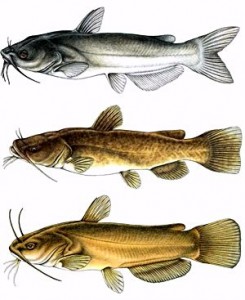 Catfish (order Siluriformes) is a collective name for a large group of ray-finned fish which can be found all over the world in marine and freshwater environments. Most members of the catfish families have distinctive barbels or whiskers which lend the fish its name. The whiskers of the catfish range from long and dragging to quite short, and are positioned on either side of the large round mouth, which is carried low in the face of the fish, their barbels are more important in detecting food, the eyes on catfish are generally small. Additionally, catfish do not have scales, although some have bony plates which can be mistaken for single scales. Catfish have forked tails and broad fan like fins which are usually located forward on the body.
Catfish (order Siluriformes) is a collective name for a large group of ray-finned fish which can be found all over the world in marine and freshwater environments. Most members of the catfish families have distinctive barbels or whiskers which lend the fish its name. The whiskers of the catfish range from long and dragging to quite short, and are positioned on either side of the large round mouth, which is carried low in the face of the fish, their barbels are more important in detecting food, the eyes on catfish are generally small. Additionally, catfish do not have scales, although some have bony plates which can be mistaken for single scales. Catfish have forked tails and broad fan like fins which are usually located forward on the body.
Most catfish are bottom feeders. In general, they are negatively buoyant, which means that they will usually sink rather than float due to a reduced gas bladder and a heavy, bony head. Catfish have a variety of body shapes, though most have a cylindrical body with a flattened ventrum to allow for benthic feeding.
Catfish are also eaten and fished for sport, providing a dense white meat which can sometimes be very flavorful, especially if taken from clean water. The flesh of catfish is very sturdy, and stands up well to frying and grilling, which are two most popular preparations in the Philippines.
Catfish is cultured due to its strong market demand, fast grower, few countries dominate the culture production, and being the 3rd most important freshwater fish group within aquaculture sector. Pangasius is now cultured in several countries in the world like Thailand, Nepal, Pakistan, India, Bangladesh, Vietnam, Laos, Myanmar, Indonesia, and Cambodia.
In the Philippines, Pangasius is the most popular cultured catfish. It is an air-breathing catfish that can tolerate low Dissolve Oxygen (DO) of the water. It can be cultured in fishponds, concrete tanks, fish cages or fish pens.
How to culture Catfish
Common Cultured Pangasius:
- Scientific name: Pangasius hypophthalm. English name: Sutchi river catfish.
- Scientific name: Pangasius bocourti. English name: Bocourts catfish
Site Selection
- Efficient source of water
- Free from pollution
- Free from any disturbance
- Free from poachers
- Source of electricity
Size of Culture System
Pond
- The ideal pond compartment is 1,600 to 2,400 sqm.
- The ideal water depth is 1.5-2 meters.
Cage
- The ideal size is 10×10 meters.
- The ideal depth is 5 meters.
- Stocking density is 15-50/m3
Pond Preparation
Pond preparation is the same as general preparation for fish ponds.
1. Draining and sun drying. Sundry the pond until the pond bottom cracks to eliminate depending on the culture environment. Stocking should be done early morning or late afternoon. Survival rate of Pangasius spp. is estimated to be 80-90%.unwanted fish species and condition the pond.
2. Repairing of dikes and gates. Dikes and gates should be repaired to avoid entry of other fish and escape of stocks.
3. Eliminating predators. Predatory fish species should be eliminated to promote better yield and harvest.
4. Liming. Liming is done primarily to condition pond soil, since Pangasius spp. can tolerate pH ranging from Q.5-7.5.
5. Filling of water. Fill the pond with water to about 1.5m to 2m deep, to provide a wide environment for the stocks.
6. Stocking/stocking density. Pangasius spp. can be stocked at a rate of 3-15 pcs/m2
Pond Management
1. Feeding/feeding management. Pangasius can be fed with kitchen waste, rice bran or pelleted feeds (recommended for faster growth and better fish quality) at a rate of 2.5% of their average body weight (ABW) and will be adjusted bi-weekly. Feed Conversion Ratio (FCR) averages to 1.5:1, which makes it a suitable for culture. Pangasius is omnivorous (eat other plants and animals) during their first year and become herbivorous for the following years.
Since they are omnivorous, the Pangasius Catfish or Iridescent Shark Catfish will generally eat all kinds of live, fresh, and flake foods. To keep a good balance give them a high quality flake food or pellet everyday. Feed brine shrimp (either live or frozen) or blood worms. As they get older they loose their teeth, and like the Pacus, become more and more vegetarian.
“Home-made” mixture of boiled vegetables, rice-bran and broken rice may also be used for feeding.
2. Water management. Water is important for all fish, so optimum conditions for certain parameters of water should be the primary factor to consider in engaging to fish culture. Water quality parameters like pH (6.5-7.5), Dissolve Oxygen (DO) (0.1 mg/l), Temperature (25-30° C), Salinity (<2 style=”font-weight: bold; font-style: italic;”>3. Sampling. Sampling is done to monitor the growth of stocks and to compute feeds to be given to the stocks for the following days. This is also done to see if the stock reaches its marketable/harvestable size. Since Pangasius spp. is fast grower fish, sampling is mandatory.
Harvesting
Harvesting can be done in partial (selective harvesting) or total harvesting. Pangasius spp. can be harvested for about 5-6 months of culture period. lt can reach the weight of 1-1.5 kilogram in 5-6 months culture given the proper pond management.
Sources : www.bar.gov.ph